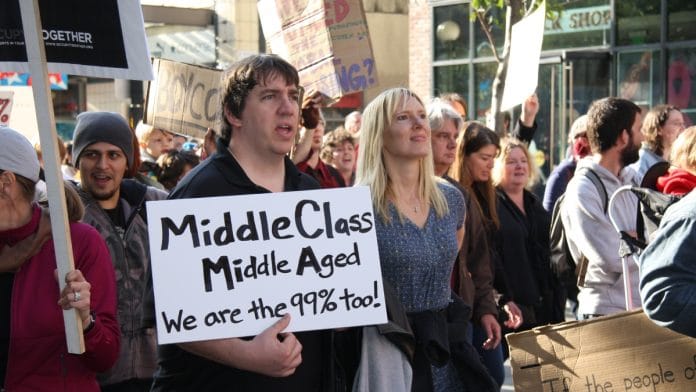In 2007, a World Bank report coined the concept of the “middle-income trap.” At the time, the term was used to describe countries mostly in Latin America and the Middle East who, despite economic growth and falling poverty rates, were never able to become high-income countries.
Today, the “middle-income trap” continues to burden over 100 countries around the world, according to the World Bank’s 2024 World Development Report. But what exactly is the “middle-income trap”?
And, more importantly, how can countries overcome it — or avoid the trap altogether?
‘Superficial measures of economic efficiency’
At the end of 2023, the World Bank classified middle-income countries as economies who have a gross national income (GNI) per capita ranging from $1,136 to $13,845. Within the grouping, countries can further be classified as lower-middle-income countries (GNI per capita of $1,136 to $4,465) and upper-middle-income countries (GNI per capita of $4,466 to $13,845).
Today, roughly 75% of the global population live in middle-income countries, including an estimated 66% of people who live in extreme poverty, according to the World Bank report. Middle-income countries, the report adds, are responsible for 40% global economic output.
Currently, there are 108 countries — including major economies like China, Brazil, Türkiye and India — stuck in the “middle-income trap”, according to the World Bank.
The World Bank’s report describes the “middle-income trap” as a situation where middle-income countries face serious headwinds related to economic growth, wage competition and innovation, and often rely on “policies predicated on superficial measures of economic efficiency.” The circumstances, the report adds, make middle-income countries “especially prone to premature slowdowns in development.”
In a separate report, the International Monetary Fund notes that countries that have been stuck in the “middle-income trap” in recent decades have found themselves “caught between the rapidly changing advanced technology of rich countries, and competition in mature products from poor countries with low wages.”
The World Bank maintains that growth prospects for middle-income countries depend on their ability to increase production through innovation — a difficult feat for many economies to achieve at scale. The organization’s report adds that for many middle-income countries, achieving high-income status could take multiple generations if current economic growth rates hold.
“Most middle-income countries remain wedded to an approach out of the last century: policies focused heavily on attracting investment,” Indermit Gill, the World Bank’s Chief Economist and a member of the World Economic Forum’s Chief Economists community, told the Forum. “That’s the equivalent of driving a car entirely in first gear: it will take forever to get to the destination.”
Escaping the trap
In recent decades, only a few dozen countries have grown from middle-income countries into high-income countries. This includes Saudi Arabia, Latvia, Bulgaria and South Korea, among others.
In its report, the World Bank outlines a three-pronged approach that countries can follow to avoid the “middle-income trap”. The plan — dubbed the 3i strategy — entails a strategic calibration of economic policies related to investment, infusion and innovation.
First, low-income countries should focus primarily on increasing investment in the economy. In 2001, for example, Colombia was able to increase investment in the country by implementing various reforms that included limiting government spending, introducing a floating exchange rate and boosting central bank independence.
Once a country has reached lower-middle-income status, policies should be adjusted to facilitate a mix of investment and infusion. In particular, infusion should be focused on expanding the use of advanced technologies.
Then, after reaching upper-middle-income status, countries should complement investment and infusion with innovation. The addition of innovation, the report notes, requires “restructuring enterprise, work, and energy use once again, with an even greater emphasis on economic freedom, social mobility, and political contestability.”
The World Bank’s report lauds South Korea as an example of a country that has effectively implemented the 3i strategy.
In the 1970s and 1980s, South Korea pursued reforms to encourage private investments and industrial policies that boosted technology use and production efficiency. Subsequent economic growth was staggering; South Korea’s per capita income rose from $1,200 in 1960 to $33,000 in 2023, according to the World Bank.
In a statement to the Forum, Gill added that in order to attain high-income status, governments in middle-income countries “must enact competition policies that create a healthy balance between” companies ranging from large corporations to startups.
“The benefits will be greatest when policymakers focus less on the size of the company and more on the value it brings to the economy, and when they encourage the upward mobility of all of their citizens instead of fixating on zero-sum policies to reduce income inequality,” Gill stated.
‘Far heavier burden’
Experts note that achieving sustained economic development across middle- and low-income countries is not an easy task — especially given the economic uncertainties that continue to burden the global economy.
“Middle-income countries now face far heavier burdens than their predecessors did: ageing populations, geopolitical and trade frictions, and the need to speed up growth without fouling the environment,” Gill stated.
Nonetheless, by outlining a new formula for facilitating economic growth, the World Bank’s 2024 World Development Report says it aims to make the “expression ‘middle-income trap’ completely obsolete.”
This article previously appeared in the World Economic Forum.






